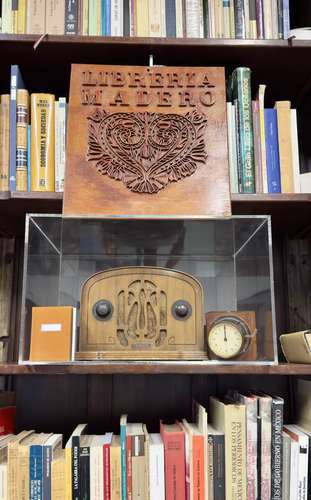Among the jewels kept by the Don Enrique Fuentes Fund/Librería Antigua Madero is the first facsimile edition of the Picturesque and historical atlas of the United Mexican States (1885), by Antonio García Cubas; he constitutionalist yearbook (1916), and the extraordinary number of Bulletin of the National Library of Mexico (1909), by its director Francisco Sosa.
This special reserve collection is housed in the library of the Universidad del Claustro de Sor Juana (UCSJ), with the aim of preserving the memory of the emblematic Madero bookstore, later known as Antigua Librería Madero.
By agreement of the family, this collection was received in November 2023. Among the oldest materials are the Report from Matías Romero to the governor of the State of Oaxaca, dated August 25, 1880; Brief biographical sketch of the most notable members of the telegraphic branch and historical review of the existence and progress of telegraphs in the Mexican Republic, by Lázaro Pavia (1893), and Scientific bibliography of the state of Mexico, by Manuel de Olaguíbel and Enrique Iglesias, published in 1899.
Other titles that stand out are: Antigua Madero Bookstore: The art of a trade (2012), by Enrique Fuentes Castilla; Famous prints and rare books (1991), first facsimilar edition, by Manuel de Olaguíbel; Printing work of five decades (1997), by Pierre Aleschinsky, y Xiquipilco-Temoaya Codex and Otomi land titles: Settlements, documents and indigenous rights in conflict, 16th-18th centuries (1999), by René García Castro.
A part will go to the Library Network
The books and prints included in the collection cover a wide variety of topics, although with an emphasis on history. Andrea Fuentes Silva, daughter of the former director of the Antigua Madero Bookstore, donated an original collection of 4,000 books to the UCSJ, an institution that kept 2,091 books. The remaining books, whose titles were duplicated, in agreement with the Fuentes Castilla family, will be donated to other entities belonging to the Historic Center Library Network, to guarantee conservation, preservation, dissemination and good use.
It is not just about the books, however, but about the furniture of the bookstore; that is, the historical bookseller
and the display case behind which Don Enrique worked. The bookshelf, full of titles, now shines in all its splendor, like a site museum
on the upper floor of the library.
At first, this piece of furniture was part of the wooden shelving of the Sanborns Bros. joint drugstore and soda fountain. The display case houses the oldest materials, dating back to the 19th century. Andrea Fuentes also provided objects such as the bookstore’s original shield, made of wood, a radio and a clock.
For Luis Torres Acosta, director of Cultural Diffusion at UCSJ, Fuentes Castilla was a relevant figure in the history of literary culture in Mexico. Beyond a book business, the bookstore was a space for research and knowledge. Everyone passed by, and Don Enrique talked with all of them. People were going to leave their books. Not everything was collectible, there were new editions, already in the sales logic
.
▲ In addition to titles, objects and furniture from the Enrique Fuentes-Librería Antigua Madero Fund were donated.Photo Roberto García Ortiz
The Madero bookstore was founded by the Spanish republican Tomás Espresate on Avenida Madero number 12. Fuentes Castilla arrived there in 1987. In 2012, he moved to the Casa de la Acequia, on the corner of San Jerónimo and Isabel la Católica, almost in front of the UCSJ. Torres Acosta remembers that Don Enrique “went to eat almost every day at Zéfiro, the restaurant in the Claustro de Sor Juana. Furthermore, every time we were going to publish a new issue of our magazine Castalid Flood, We were going to talk to Don Enrique about the subject.
At some point, while chatting with Andrea, the idea of receiving the library’s collection at the UCSJ arose, as a kind of evolution of the project to not let an effort die that had seen practically the entire second half of the 20th century and what we have of the XXI. From the moment the go-ahead was given, it turned out to be a long process, because some renovations were made to the library.
Of the Revolution, Juárez and Sor Juana
Fabiola Escalona Galván, director of the library, said that the first step upon receiving the collection consisted of making a meticulous inventory against the catalog they gave us, which was the original from the bookstore, because it still had prices for the books. The most relevant topics we found had to do with the Mexican Revolution in different states, as well as the history of Benito Juárez and the Reformation. There are catalogs of museums and exhibitions, architectural plans of churches or government buildings in different years, catalogs of coins and banknotes, logs of government newspapers, reports of governments or figures during their administrations, as well as books related to agriculture and the sea. There is also a lot of religious books and books on the architecture of churches in the Historic Center. We even found a collection of Sor Juana
.
It is not common for the UCSJ to receive libraries or collections as a donation. The case of the Fuentes Castilla collection has to do with our link with the Historic Center and the project that Don Enrique had, from what we know, the Antigua Madero Bookstore meant for Mexico City. We want to be part of this and host it in a place that is accessible to everyone, as well as safe.
points out Torres Acosta.
Although UCSJ’s commitment is, first of all, to its student body, it is also to the community and the surrounding area. It is expected that the Don Enrique Fuentes Fund/Antigua Madero Bookstore open this space for the public from outside about the great history of Mexico
.
